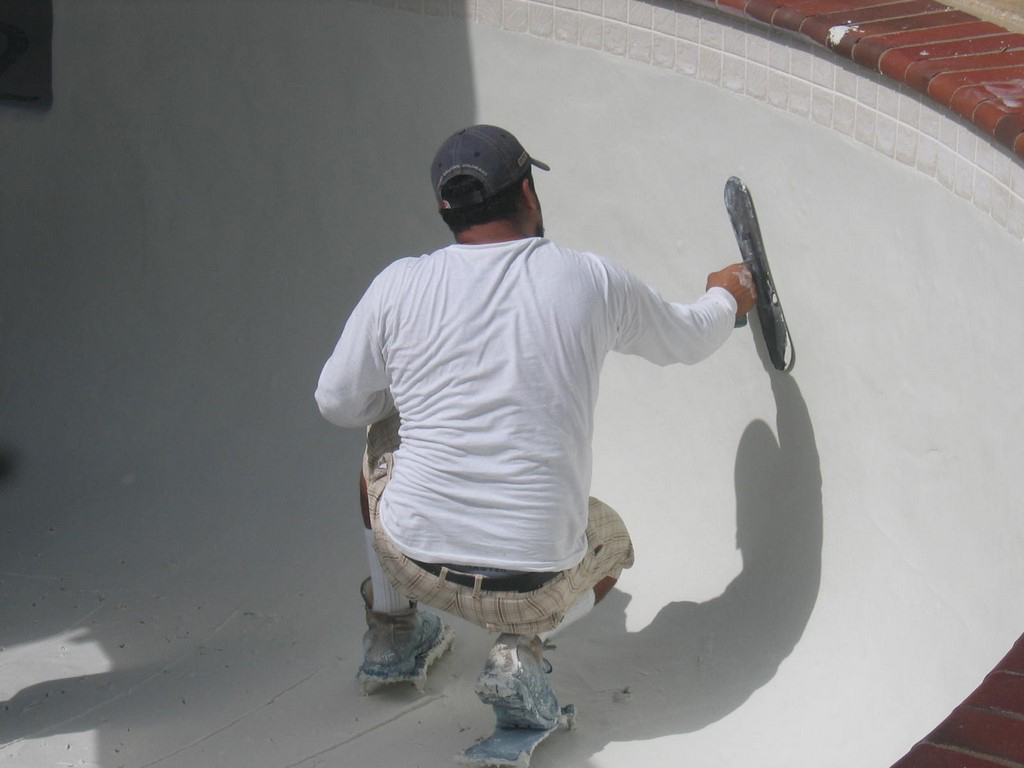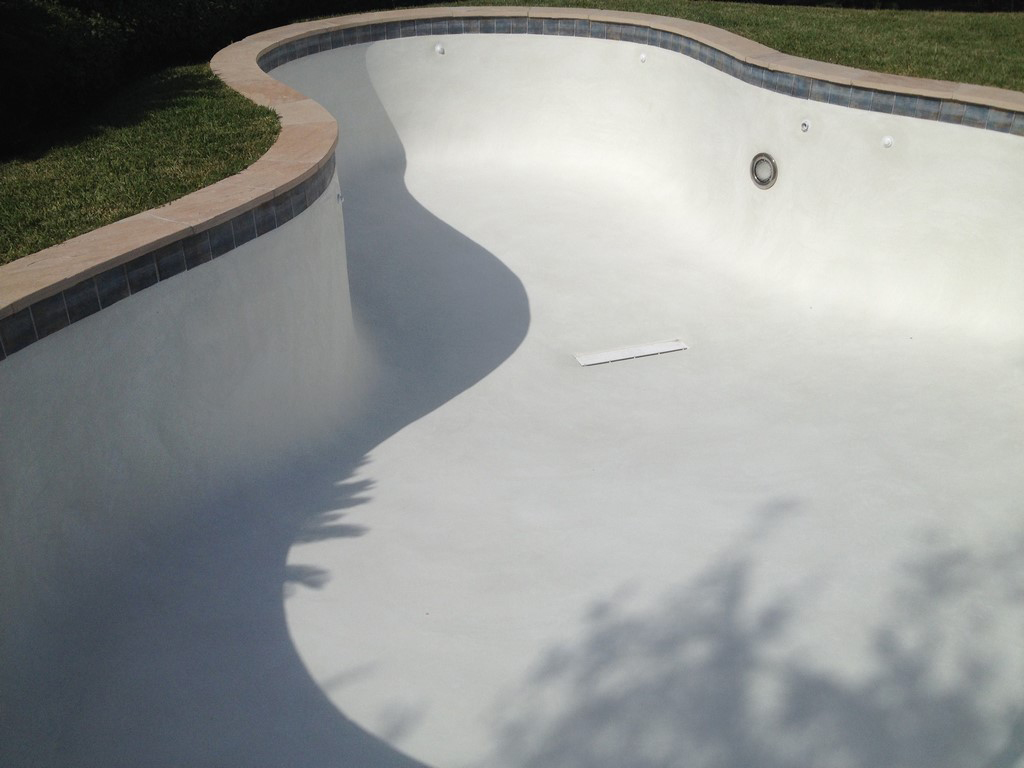Watching pH

 What happens when the water added to a newly plastered pool has had a chance to interact fully with its new surroundings? That’s a big question, writes Kim Skinner — one that has implications for the long-term appearance and maintenance of countless watershapes.
What happens when the water added to a newly plastered pool has had a chance to interact fully with its new surroundings? That’s a big question, writes Kim Skinner — one that has implications for the long-term appearance and maintenance of countless watershapes.
For many years, technicians who regularly service a wide variety of swimming pools have been widely aware that pH levels tend to rise much faster in plaster swimming pools than they do in vinyl-liner or fiberglass pools.
What’s the difference? Basically, it’s all traceable to Portland cement, a cementitious component in plaster (as well as quartz and pebble) finishes and a basic ingredient in all concrete products. There is no Portland cement on the surface of a fiberglass or vinyl-liner pool, but there’s plenty of it in a plaster pool.
In this article, which is a brief follow-up to “Active Water” (WaterShapes, June 8 — click here) and expands on a point raised in the sidebar toward the end of that article, we’ll take a look at what happens once water is added to a newly completed swimming pool and has a chance to interact with its new surroundings. We’ll also consider why this is information of which pool designers and builders should be as conscious of as are service professionals.
IN THE MIX
When the plastering crew arrives on a job site to apply a new finish to a recently completed pool shell and, often, its accompanying spa, they will combine Portland cement with water and add an aggregate (either limestone, quartz or pebble) and, depending on the situation, an accelerator additive to complete the mix.
Only the cement portion of the mix reacts with the water: The aggregate is inert and is there to add structural strength to the final product.
When water and Portland cement come into contact with each other, hydration occurs and a hardening gel known as calcium silicate hydrate begins to form. Another byproduct of this process is calcium hydroxide, which makes up about 20 percent of the material within the matrix and at the surface. It is this calcium hydroxide byproduct that can and will affect the pool water’s balance – especially the pH.
 This is so because calcium hydroxide has a very high pH of about 12.0. Unfortunately, this hardened material is somewhat soluble in LSI-balanced water, especially when the plaster is brand new and has been recently mixed, applied and troweled to a new smooth finish. Thus, when new plaster pools are first filled with tap water, it is inevitable that some of the calcium hydroxide at the surface will begin to dissolve into the water and, just as inevitably, cause the pH and calcium levels to rise.
This is so because calcium hydroxide has a very high pH of about 12.0. Unfortunately, this hardened material is somewhat soluble in LSI-balanced water, especially when the plaster is brand new and has been recently mixed, applied and troweled to a new smooth finish. Thus, when new plaster pools are first filled with tap water, it is inevitable that some of the calcium hydroxide at the surface will begin to dissolve into the water and, just as inevitably, cause the pH and calcium levels to rise.
This is where the problems can start. Once the dissolved calcium hydroxide starts reacting with the water’s alkalinity (that is, its bicarbonate level) and with the aqueous carbon dioxide found in the water, a calcium carbonate precipitate starts to form. As anyone who’s started a pool knows, this is the familiar “plaster dust” that is seen on the bottom of many pools. When the newly filled pool’s walls and floor get a routine early brushing, this plaster dust can make the water milky and cloudy.
Under typical conditions, it’s not uncommon with new plaster pools to see the calcium level increase by about 25 to 75 parts per million and the pH to rise to a level above 9.0 by the time the pool is filled with tap water. It’s at this point that the start-up technician begins dealing with these various actions and reactions and confronts the difficulties of balancing the water.
ON GUARD
All of this is why the team at onBalance, a group that studies pool-water chemistry, has recommended use of the bicarbonate start-up method for all new plaster pools (for information on this approach, click here). It offers the start-up manager the best way to keep the pH below 8.4 and prevent the calcium hydroxide from dissolving out of the plaster (or quartz or pebble) finish, and forming calcium carbonate “dust.”
Under those controlled conditions, in other words, plaster dust does not form and cannot affect the pH.
|
Saline Solutions Saltwater chlorine generators are known to cause the pH to rise much more quickly than is the case in other pools. The reasons for this haven’t been fully defined, but one supposition is that the aeration of the water in the salt units’ cells removes carbon dioxide from the system and therefore, as was explained in “Active Water,” causes pH to rise. Dealing with this situation is a challenge for service technicians – and a factor to be considered by designers and builders who are guiding their clients through various equipment configurations and possibilities. — K.S. |
An important point to add here is that the new plaster surface will continue to interact with the water for many months, even after the surface stabilizes and plaster dust is no longer forming. (Usually, this happens about two weeks after the water is added.) But the plaster and the water will continue to interact for an extended period beyond that, causing the plaster surface to become carbonated.
The main observable result of this reaction is a pronounced tendency for the pH to rise – not as rapidly as it might have done at first, but gradually just the same. And that pH rise is in addition to the usual pH rise attributable to the off-gassing of carbon dioxide.
This process in which completed plaster pools effectively “mature” over a long period of time is much more than a service issue. Indeed, it’s a key to long-term client satisfaction with a project – and something a designer or builder can effectively control by specifying the manner in which a plaster pool is introduced to the water it will contain.
This is not a factor with fiberglass or vinyl-liner pools, but these processes and gradually rising pH levels are definitely something to watch for in pools with cementitious finishes, basically for the life of the pool.
Kim Skinner began his work in the pool industry 50 years ago, starting as an employee and eventually becoming manager of Skinner Swim Pool Plastering in Sun Valley, Calif. He later became president of Pool Chlor, a chemical service firm with offices throughout the Southwest. He is also a partner in onBalance, a consulting firm that performs both laboratory and field research on pool-water chemistry and on the relationships between water chemistry and pool plaster surfaces.









